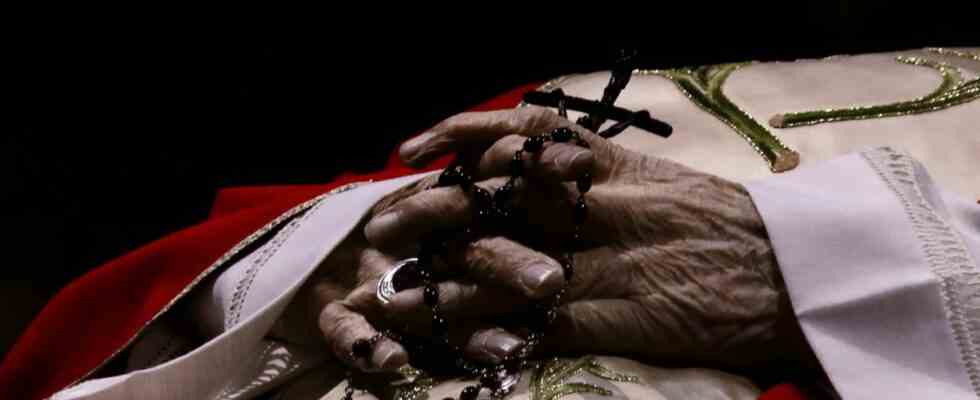“Santo, santo, santo subito!” If now before the funeral mass for Benedict XVI. If the requiem for John Paul II is repeatedly reminded, then this also has something to do with this choir, in the cadence of a stadium choir that rose into the Roman sky on April 8, 2005.
It was a blustery day, and strong winds billowed the clergy’s robes and ruffled the hair of the many guests. 300,000 believers were there, they also filled the side streets of the Piazza San Pietro, something the Vatican had never experienced before. The Pole Karol Wojtyla was once a rock star of the church. There were also many young people there. They were called “papa boys”, during the pontificate they had been seen in the stages of youth days, always loud and colourful.
Then, when the homily of Joseph Ratzinger, then Dean of the College of Cardinals, was over, the boys joined in this chorus: “Santo, santo, santo subito!” And clapped their hands. Many agreed. So he was to become holy immediately, John Paul II, who had suffered for so long before his death: without lengthy procedures, preferably right here and now.
Georg Gänswein believes: “It will go in this direction.”
In its shortened form, “Santo subito”, the song was to become the winged term that Italians have used for almost everything ever since, often ironically and profanely. But back then, on that April day, the chorus was the demand for a fast track for the beatification and canonization of “Giovanni Paolo”, even more: for a fast track. Should this now become a tradition?
The longtime private secretary of the emeritus pope, Archbishop Georg Gänswein, has already promised an early beatification and canonization by Pope Benedict XVI. brought into play. When asked about the slogan “Santo subito,” he told private Catholic broadcaster EWTN: “I think it’s going in that direction.”
A canonization – also called canonization or “raising to the honor of the altars” – is actually associated with high hurdles in the Catholic Church and can take hundreds of years. Before a person can become a saint, they must first be beatified. The initiative for this usually comes from an order or a diocese that makes representations to the Apostolic See. A so-called “postulator”, a challenger, must then collect the person’s biographical data, texts and testimonies and submit a kind of report to the Dicastery for the Causes of Saints. At the end, an “advocatus diaboli” comes into play, a devil’s attorney who collects counter-arguments. The Pope decides on canonization.
John Paul II achieved this ecclesiastical dignity in record time. The process for his beatification began just 87 days after his death. Benedict XVI himself had lifted the usual waiting period of several years after death. At the time, the postulator spoke of an “avalanche of mail” with proclamations of miracles that he was receiving from all over the world.
As early as May 2011, Benedict XVI spoke to him. Blessed, in April 2014 he was canonized by Francis. The prerequisite for canonization is that someone either becomes a martyr, i.e. dies for their faith, or who has caused two healing miracles confirmed by doctors.
John Paul II is said to have healed two women post mortem
John Paul II is credited with healing two women: The French nun Marie Simon-Pierre from Aix-en-Provence, who was seriously ill with Parkinson’s disease, is said to have called on the deceased, who once suffered from the same disease, to intercede every day – in June 2005 the suffering then disappeared overnight. And in May 2011, Floribeth Mora Diaz from Costa Rica is also said to have recovered from a life-threatening vasodilatation in the brain after an invocation to prayer.
John Paul II himself had started a kind of assembly line for canonizations during his lifetime: During his tenure, he beatified 1,338 people and made 482 saints – more than any of his predecessors combined. However, the canonization of popes by popes is not without controversy. Already in the case of John Paul II, church historians warned against taking a hasty shot and that credibility would suffer in the long run with such mutual pontifical honorifics.
For example, John Paul II is accused today of not adequately investigating allegations against Theodore McCarrick prior to his appointment as Archbishop of Washington in 2000. McCarrick was released from cardinal and clerical order in 2019 for sexually abusing children. Research by a Dutch journalist has recently raised the question more urgently than ever as to whether the saint still covered up abuse when he was a bishop in Poland.
The canonization of popes in particular has increasingly become a means of church politics. But the monument is already being carved in other ways. Benedict XVI is not even buried when his longtime private secretary Georg Gänswein is already shooting poisoned arrows in the direction of Francis.
In the interview reports the monsignor that the papa emeritus has Francis’ decree “Traditionis custodes“, with which he again restricted the celebration of the Latin Mass in 2021, “read with pain in the heart”. Gänswein also announced his book about his life at the Pope’s side, which will be published initially in Italy, with the title “Nient’altro che la verità” (Nothing but the truth).
But can a pope be beatified who has been accused of making false statements in his response to an abuse report? Benedict XVI was “shocked” that he was called a liar, said Gänswein. The fact that in his statement for the Munich report it was falsely claimed that Ratzinger had not been present at a meeting was the mistake of an employee, and this has been corrected. Nevertheless, the “narrative” that portrayed the former pope as a liar remained. Santo subito?

